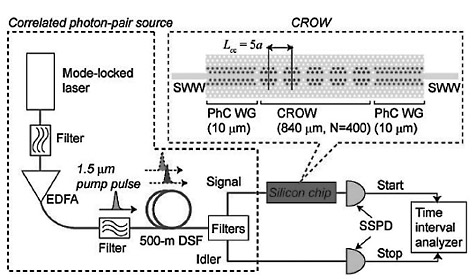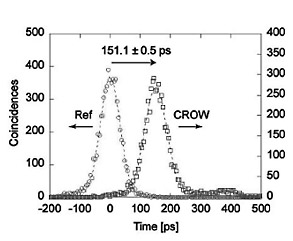An On-Chip Single Photon Buffer Based on Coupled Resonator Optical Waveguide
Hiroki Takesue, Nobuyuki Matsuda*, Eiichi Kuramochi*,
William John Munro, and Masaya Notomi*
Optical Science Laboratory, *NTT Nanophotonics Center
Integrated quantum optical circuits are now drawing attention as a way to realize advanced quantum information processing using photons. Several core elements such as entanglement sources, gates, and detectors have been already realized. In addition to these functions, single photon buffers on a chip will help us to realize reconfigurable integrated quantum optical circuits. Here, we report a single photon buffer experiment using a coupled resonator optical waveguide (CROW) based on silicon photonic crystal cavities [1].
Figure 1 shows the experimental setup. 1551.1-nm, 20-ps pump pulses were injected into a dispersion shifted fiber (DSF) to generate correlated photon pairs via spontaneous four-wave mixing. The signal photon from a pair at a wavelength of 1546.70 nm was coupled to the CROW with a lensed fiber, and then received by a superconducting single photon detector (SSPD), while the idler photon (1555.53 nm) was directly received by another SSPD. The detection signals from the SSPDs were input into a time interval analyzer for coincidence measurements. A schematic of the CROW used in the experiments is shown in the inset of Fig. 1 [2]. We used a CROW whose lattice constant and inter-cavity distance were 420 nm and 2.1 µm, respectively. The number of cavities was 400, which means that the total length was 840 µm. The silicon chip that included the CROW was equipped with another waveguide of the same length, where the CROW section was replaced with a line defect waveguide. This waveguide was used as a reference for the temporal delay.
Figure 2 shows the coincidence histograms when the signal photons transmitted through the CROW (□) and the reference waveguide (○). We observed a clear shift of the coincidence peak by 151.1±0.5 ps when the signal photon passed through the CROW. This result suggests that the speed of the pulsed photons were slowed to 1/59 of the light speed in a vacuum. We also observed the cross correlation between the signal and idler photons and found to be 3.25 ±0.06, which indicates that a non-classical intensity correlation was preserved after the photon buffering in the CROW. In addition to this experiment, we successfully tuned the delay time by 50 ps using the temperature dependence of the CROW dispersion characteristics. Finally, we experimentally confirmed that a time-bin entangled state could be preserved in the CROW.
- [1]
- H. Takesue, N. Matsuda, E. Kuramochi, W. J. Munro, and M. Notomi, Nature Commun. 4 (2013) 2725.
- [2]
- M. Notomi, E. Kuramochi, and T. Tanabe, Nature Photon. 2 (2008) 741.
 |
 |
- Fig. 1.
- Experimental setup.
|
|
- Fig. 2.
- Time-interval histograms around coincidence peaks.
|
<< Prev | Contents | Next >>

